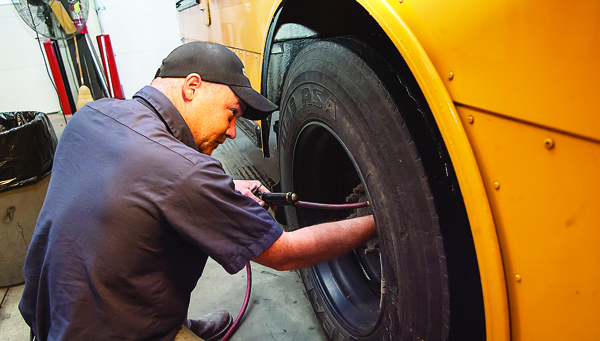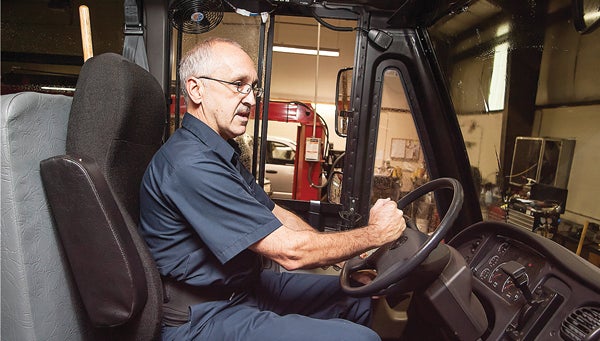Garage staff makes ure the wheels keep going ’round and ’round
Published 8:52 am Monday, October 20, 2014

Photo by Brandon Hicks
Jonathan Bowers, shop foreman at the Carter County school bus garage, checks tire pressure during a routine safety inspection on one of the buses in the system’s transportation fleet. (For more photos visit www.elizabethton.com)
Monday kicks off National School Bus Safety week — and safety is something the Carter County School System takes very seriously, especially when it comes to children.
“Drivers do a daily check on each bus every day. It’s called a ‘Pre-Trip,’” said Wayne Sams, manager of the Carter County school bus garage.
Sams said drivers do a safety inspection on their bus every morning and afternoon before they start their route using an extensive checklist. Everything from fluid levels, hoses and belts, mirrors, lights, buzzers, brakes, tires, heaters, emergency exits and numerous other items are inspected on a daily basis by the drivers.
Then, every 45 days, each vehicle comes into the garage for an extensive maintenance check by the garage’s mechanics.
The safety checks are something new that the bus garage started this year, Sams said, adding the checks are required by the state.
Having the daily checks has been a big help, Sams said, because it allows the bus drivers to monitor the condition of their vehicle and report if any repairs are needed. Additionally, Sams said the logs help him keep track of mileage on the buses as well as fuel usage.
Every day, the Carter County School System operates 58 bus routes. During the course of the average week, the school buses travel approximately 14,000 miles along the roadways of Carter County.
Sams said the school system’s nine special needs buses run a lot of miles, more than a regular bus travels. “One does right at 400 miles a day,” he said.
With that many miles traveled each day, safety and having the buses in tip-top shape are very important.
“I don’t want to get one of these buses out and have a tire blow and kids get hurt,” Sams said.
That focus on safety is also one of the driving forces behind the dreaded school snow day cancelations.
Sams said when inclement weather arrives he works closely with Director of Schools Kevin Ward to make the determination of whether or not to cancel school.
“We start at about 4:30 or 5 in the morning checking these roads,” he said. “You make the best judgment possible for the children’s safety. It’s about whether we can get from point A to point B safely.”
One of the biggest safety concerns for the bus drivers is vehicles that do not stop when the bus has stopped to pick up students or let them off to go home.
“It’s something we battle constantly every day,” Sams said.
Sams said while the bus drivers can’t control what other motorists do, there are some steps they can take to protect the child’s safety.
“We do not let that kid off until we know that traffic has stopped,” he said.
Sams said he feels many of those who fail to stop — or those who pass a stopped school bus — don’t intend any harm, they may not have seen the buses’ lights and sign or they may simply not know the law when it comes to a stopped school bus.
According to Sams, the following list of guidelines should be followed by drivers when encountering a stopped or stopping school bus:
• All drivers meeting or following a school bus, from any direction, must stop to allow the loading or unloading of children;
• Drivers may resume travel after the bus begins travel and the visual warning signs and indicators of the bus are no longer activated; and
• Drivers encountering stopped buses from the opposite direction must also stop and observe the same regulations. The only exceptions are involving vehicles traveling in opposite lanes of travel on a roadway that maintains a physical divider or barrier — such as a concrete or grass median — between opposite lanes of travel. A turn lane doesn’t qualify under that exception, and vehicles traveling in the opposite lanes are still required to stop for buses.

Photo by Brandon Hicks
Dan Richenberg, a mechanic at the Carter County school bus garage, performs a routine safety check on a bus — including checking to make sure all the bus lights and stop sign are properly working. (For more photos visit www.elizabethton.com)




